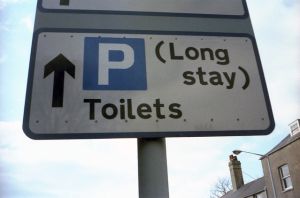When Customer Engagement Actually COSTS A Company Money
by Robert Bacal
 In part one of these series, we mentioned that if you increase customer engagement (whatever that means, and there’s no universal definition), the result “may be that you see positive results (e.g. more sales), OR, it may have no effect, and finally, you may end up with a negative return (less sales).
In part one of these series, we mentioned that if you increase customer engagement (whatever that means, and there’s no universal definition), the result “may be that you see positive results (e.g. more sales), OR, it may have no effect, and finally, you may end up with a negative return (less sales).
In Part 2 of this series, we’ll look at actual examples where increased customer engagement actually harms businesses.
In fact, what’s startling is that for many, perhaps most companies, customer engagement is a really bad thing to strive for.
Example 1: Restaurants And Cost Of Customer Engagement
In part 1 we mentioned that because high end restaurants operate on fairly low profit margins, they need to turn over tables, each and every night to stay in business. This also applies to other lower end restaurants.
The more customers engage and interact with their environment in a restaurant, the longer will be their stays. In turn, if there is limited seating space, the longer they stay, the fewer customers can be served. Since the overhead costs of running a restaurant are relatively fixed regardless of number of customers (it costs close to the same to have a restaurant open for ten customers as it does for thirty customers). The longer the stay, and presuming they are not ordering more feed), the lower the profit.
But…
But, as an illustration as to why you have to look carefully at trying to increase engagement, consider that IF a longer stay means more customers are purchasing alcohol, then the equation changes. Alcohol has much larger margins than food does, so the longer the stay and the more drinks, the better the profit. But it’s not automatic. Some establishments rely on drink sales, and some do not. Clearly, if you end up serving less customers as a result of longer stays, you need to make up a lot of money through higher alcohol sales, over and above what you would have otherwise.
McDonalds is an interesting case, too. Many provide play areas for kids, in order to both pull in families, and to increase visit length, with the assumption that if families stay longer, not only will they make iniital purchases, but they will go back for something else (i.e. another coffee, a soft drink, dessert they didn’t buy at first.
So even within an industry, you can’t know if increasing customer engagement will be a positive or a negative.
Retail Showrooming A Good Example Of Failure Of Customer Engagement
You may be familiar with showrooming, which means that customers visit bricks and mortar stores to find out what product they might want but THEN go online, usually to another company, to actually order the product.
So, in effect, you have “customers” who are interacting with the store, its products and even employees, only to make their buying decision, and go online to buy it cheaper. The engagement is “high”, but it’s the wrong customers being engaged in the wrong ways. In this scenario, “engagement” is at best neutral in terms of business results, or, in fact negative.
How Can It Result In Less Sales?
While it might seem that customers involved in showrooming, and thus not going to buy from the business, is revenue neutral, because it doesn’t cost the company to have more customers wandering around, but that’s not necessarily true.
You can end up with enough non-buying customers in the store that actually negatively impact the shopping experiences of those who ARE going to spend money. Imagine the audio store that attracts a lot of customers wanting to listen to the new, great speakers that just came out. Just for fun, and entertainment. Lots of people shop as a low cost form of entertainment.
Meanwhile the time spend auditioning speakers to “engaged” customers has an opportunity cost because while demo’ing to non-buyers, you lose the opportunity to demo to potential buyers.
So, in effect if customers are engaging with staff, they may be interfereing with serving other wanting-to-pay customers. Will a business that actively encourages long demo sessions of their audio products actually get increased sales, or simply more tire-kickers? We don’t know, but since there is a potential for lost sales, if you attract too many “not going to buy” customers, the decision to increase customer engagement needs to be looked at very closely.
Conclusion
In the next installment, we’ll look at more examples where this takes place.

